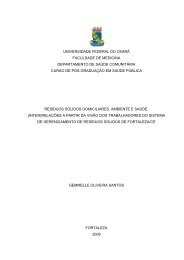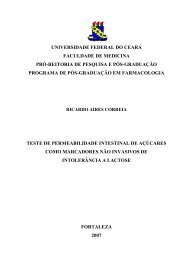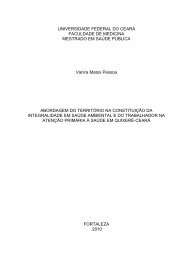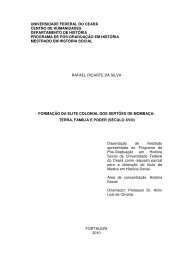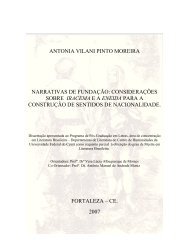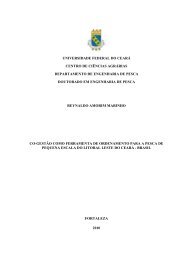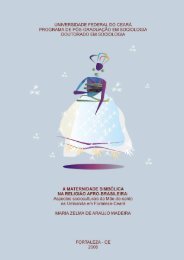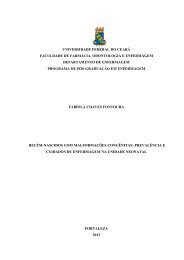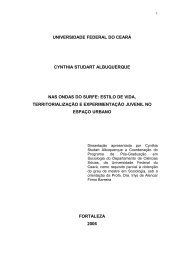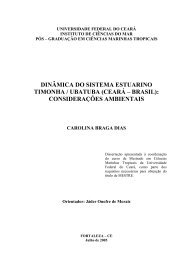Tungíase: doença negligenciada causando patologia grave
Tungíase: doença negligenciada causando patologia grave
Tungíase: doença negligenciada causando patologia grave
Create successful ePaper yourself
Turn your PDF publications into a flip-book with our unique Google optimized e-Paper software.
JAM ACAD DERMATOL<br />
VOLUME 60, NUMBER 3<br />
Table I. Prevalence and estimated incidence of scabies in rainy and dry season, stratified by sex<br />
Therefore, for further analysis the data of the two<br />
surveys were combined.<br />
The frequency of severe scabies was disproportionately<br />
high in children. The estimated overall<br />
incidence based on a mean duration of disease of 6<br />
months (range: 2-8 months) was 195.8 (146.9-<br />
587.4)/1000 person-years. The incidence was higher<br />
in female (205.5; 154.1-616.5) than in male (184.2;<br />
138.2-552.6) individuals, however, similar to the<br />
prevalence, the difference was not significant.<br />
In 4 age groups (10-14, 15-19, 20-39, and 40-59<br />
years) the infestation occurred more often in female<br />
than in male individuals; however, the difference<br />
was only significant for 20- to 39-year-olds (P = .04).<br />
A particular pattern emerged when data were stratified<br />
according to age, sex, and season of the year.<br />
Whereas in the rainy season age-specific prevalence<br />
in female individuals was consistently higher than in<br />
male individuals (with exception of the elderly)<br />
and prevalence curves were almost parallel, in the<br />
dry season, prevalence in women remained higher<br />
only in 4 of 7 age groups as compared with men.<br />
Moreover, although in the rainy season prevalence<br />
peaked in small children, children aged between 10<br />
and 14 years, and adults aged 40 years or older, in the<br />
dry season the prevalence of scabies in boys and<br />
men decreased constantly with increasing age. In<br />
contrast, in female individuals two peaks were observed:<br />
one in teenaged girls, and one in women.<br />
However, irrespective of sex and season, children<br />
aged 4 years or younger constantly had the highest<br />
disease burden; they accounted for 29.1% (57/196)<br />
of all scabies cases diagnosed in both surveys.<br />
Children aged 14 years or younger showed the<br />
highest prevalence as compared with all other age<br />
groups (15.5% vs 4.2%, P \.0001).<br />
Prevalence rainy season Prevalence dry season<br />
Feldmeier et al 439<br />
N % (95% CI) n % (95% CI) P value<br />
Total* 102/1014 10.1 (8.3-12.1) 94/988 9.5 (7.8-11.5) .71<br />
Sex<br />
Male 41/459 8.9 (6.5-11.9) 43/453 9.5 (6.9-12.6) .82<br />
Female 61/555 11.0 (8.5-13.9) 51/535 9.5 (7.2-12.3) .49<br />
Age, y<br />
# 4 31/154 20.1 (14.1-27.3) 26/151 17.2 (11.6-24.2) .56<br />
5-9 28/194 14.4 (9.8-20.2) 28/193 14.5 (9.9-20.3) 1.00<br />
10-14 23/154 14.9 (9.7-21.6) 18/145 12.4 (7.5-18.9) .62<br />
15-19 2/95 2.1 (0.3-7.4) 5/88 5.7 (1.9-12.8) .26<br />
20-39 7/252 2.8 (1.1-5.6) 9/241 3.7 (1.7-7.0) .62<br />
40-59 8/118 6.8 (3.0-12.9) 7/120 5.8 (2.4-11.6) .80<br />
$ 60 3/47 6.4 (1.3-17.5) 1/50 2.0 (0.0-10.6) .35<br />
CI, Confidence interval.<br />
*The 94 cases identified during second survey (dry season) were different from 102 cases diagnosed during first survey (rainy season).<br />
The results of the bivariate analysis of risk factors<br />
for the presence of scabies and severe disease are<br />
shown in Table II. Age less than 15 years, many<br />
children in the household (indicated by a ratio of<br />
children/adults [2), living in the community longer<br />
than 6 months, illiteracy, low monthly family income,<br />
poor housing (absence of a solid floor, no<br />
access to electricity, no toilet on compound), sharing<br />
clothes and towels with other family members, and<br />
irregular use of shower were all significant risk<br />
factors for the presence of both scabies and severe<br />
disease. Crowding (number of persons/household,<br />
number of individuals/room) was no significant risk<br />
factor. Most importantly, a strong correlation among<br />
young age, the presence of scabies, and the severity<br />
of disease was found. Children younger than 4 years<br />
had a 5.7-fold higher chance of acquiring scabies and<br />
a 7.6-fold higher chance for severe disease, as<br />
compared with the reference age group (Table II).<br />
In the multivariate logistic regression analysis<br />
young age, many children in the household, sharing<br />
of clothes, living in the community longer than 6<br />
months, and illiteracy remained significant risk factors<br />
for the presence of scabies and severe disease<br />
(Table III).<br />
DISCUSSION<br />
Despite the fact that in resource-poor communities<br />
scabies is an individual and public health problem<br />
characterized by high prevalence, intensity of<br />
infestation, and severe morbidity, 10,42 investigations<br />
have rarely attempted to study the epidemiology of<br />
this ectoparasitosis in impoverished settings and to<br />
identify risk factors for its presence and the severity.<br />
To our knowledge, for the Americas, no reliable<br />
community-based data are available at all. Our study



